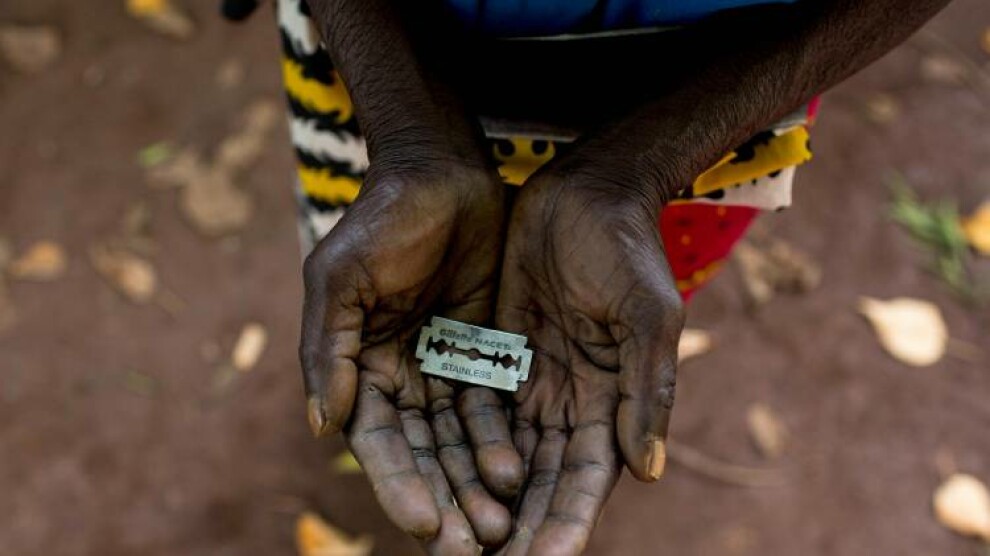Social norm that violates women's rights: FGM

News Center: The phenomenon of female genital mutilation (FGM) spreads in Africa in particular and in some Asian countries due to the religion and traditions, where the societies don’t recognize it as a violation of a women's privacy and mutilation of their organs.
Definition and types of the FGM:
The World Health Organization and the United Nations definite FGM that female genital mutilation is performed by amputating part or all of it without a medical reason.
Types of female circumcision:
The first type: is called pharaonic FGM and depends on the removal of the external female genital organs, and leaving a small opening for urination, menstruation, marriage, and childbirth.
The second type: adopts the cutting of the small and big labia with the aim of narrowing the vagina.
The third type: adopts the cutting completely or partly of the clitoris.
The fourth type: adapts the cutting completely of the clitoris or in part and small labia.
The origins of circumcision and its spread areas:
This phenomenon showed itself from Africa to Egypt with the invasion of the Ethiopians during the twenty-fifth dynasty.
Studies say that the origin of FGM backs to the time of the pharaohs.
The FGM was spread in Roma in a different way, as iron rings were put in place to prevent reproduction because they thought that the FGM saved the honor of a woman.
And Arab people have practiced circumcision since ignorance.
According to a UNICEF report, the FGM is widespread in 29 African countries, although the laws of 24 countries prohibit and punish it, but customs and traditions prohibit the application of laws.
Female circumcision in Africa:
African societies believe that the FGM completes the girls’ femininity, increasing their fertility and saving their honor, the uncircumcised girl face a look of contempt and shame on families who refuse the FGM to be performed on their daughters.
Somalia: the Somalis practice the most severe type of FGM, which is a pharaonic circumcision. It has the highest FGM operations by 98% and the targeted girls are aged between four and eight despite the Somali law prohibits it in the country and considers it as a form of torture. Article 15, paragraph 4 in the country’s law, says that (FGM is a cruel and degrading practice, and prohibited).
Egypt: According to the UNICEF, Egypt is the capital of the FGM as it allows the FGM operations openly by specialists and doctors in clinics and homes. It ranked first in the world by practicing FGM in 2014 by 82%.
The percentages varied according to the cities of Egypt, in Cairo it is 35%.
And the percentage of the FGM aged between14 and 42 is 92%, in Borsaid 15%, in Damietta 10%, in Qalyubia 68% and the highest rate is in Qena with 91%.
The percentage of the FGM aged between one and 17 is 21% and between aged between 16 and 17 is 65%.
It is remarkable in the statistics that women support the FGM more than men, due to ignorance about the history of the FGM and encouragement of society on it, as they believe that Islam recommends the FGM of the girls before being adult for their purity and to be eligible to perform their duties such as praying and fasting, and they believe that FGM protects them from sterility and serious diseases and prepares them for marriage.
Sudan: FGM operations are performed in all Sudanese cities; 83% of FGM has been performed by the Nile river state and the Northern state. The FGM rate reached 69% in 2006, and a number of girls died in rural areas because of the traditional way of using a razor without sterilization.
Yemen: The rate of FGM operations in Hodeidah province has the highest rate at 97% and Hadramout ranks second at 75%, in addition to the existence of cases of the FGM in the Aden, Mahra, and Sanaa cities, and every year three million girls face the FGM.
Iraq: The rate of the FGM cases has reached 8%, and most of them are practiced in the Kurdish provinces along the borders with Turkey and Iran. FGM cases increase in the spring.
According to a statistic of the German Wadi organization in the schools of the Kurdistan region, the percentage of girls facing FGM at the elementary school is 92% and at the secondary schools is 100%.
The FGM cases have begun to decline since 2005 due to joint awareness campaigns launched by the ministry of health and the religious organizations, stressing that FGM isn’t a duty of Muslim women and civil society organizations take on the task of educating people to not practice the FGM operations.
The high rate of FGM in conflict areas:
The civil wars in Iraq and Yemen led women to be subjected to various violations, including circumcision, the rate of the FGM in those countries increased by 16% in 2013 then by1% in 1997. As for Syria, several cases of the FGM are documented in the areas controlled by the mercenaries coming from abroad, because the FGM isn’t known very well by the societies in Syria.
The phenomenon of the FGM decreases in Africa:
The rate of FGM cases in Africa has decreased significantly in recent years. The researchers find out that the rate of the FGM practices decreased in East Africa by71%in 1995 and 8% in 2016, North Africa by 58% in 1990 and by 14% in 2015, West Africa by 73% in 1996 by 25% in 2015, in Niger from 13.2% to 0.9%.
But the decrease in the FGM rate isn’t optimistic, because the families performing the FGM take a step back because of the fear of being taken in prison by the laws.
